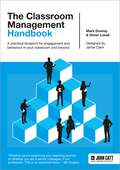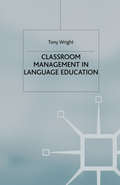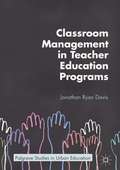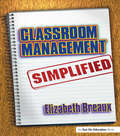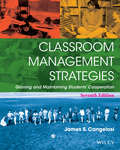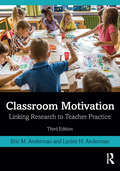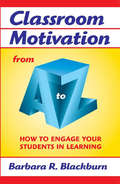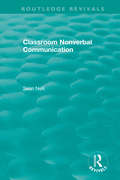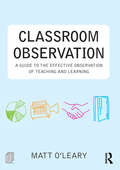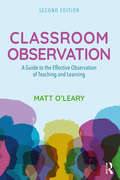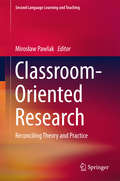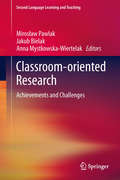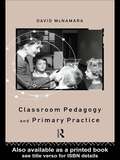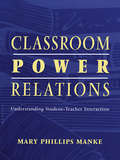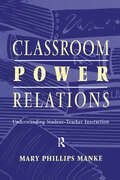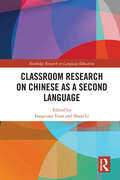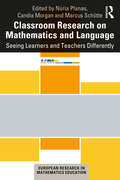- Table View
- List View
The Classroom Management Handbook: A practical blueprint for engagement and behaviour in your classroom and beyond
by Oliver Lovell Dr. Mark DowleyPerhaps the biggest factor influencing teacher wellbeing and student learning is whether students are calm, focussed, and attentive in the classroom. Despite this, most teachers feel that their teacher training allocated far too little time to the fundamental principles and practical strategies that form the foundation of effective classroom management. In this book, Mark Dowley and Ollie Lovell address this shortfall by revealing 10 principles and 18 routines that will set you up for classroom management success. The Classroom Management Handbook, is the most concise, scaffolded, and unapologetically practical guide to classroom management available.
Classroom Management in Language Education (Research and Practice in Applied Linguistics)
by T. WrightA book that develops an understanding of practices at the very centre of language education - the classroom. It is written for postgraduate students in Applied Linguistics and Education, and practitioners, whether in TESOL or other language teaching, In Part 1 the author explores key concepts in unpacking the complexity of classroom life. In Part 2 existing research and practice are examined through a series of research case studies. Part 3 provides a template for research activity and suggestions for projects and methodologies, and Part 4 collects resources for readers keen to follow up the themes developed in the book.
Classroom Management in Teacher Education Programs
by Jonathan Ryan DavisThis book investigates the impact of integrating culturally relevant and pedagogically dynamic classroom management strategies into the curriculum of an urban secondary education pre-service methods course. The book begins by framing the problem of integrating classroom management into the lives of those learning to teach impact. It then examines multiple case studies of students from the study’s control cohort who did not have classroom management coursework in their methods course. After breaking down the challenges encountered by the control students, the book offers DCMA as a framework from which teacher educators might create an integrative methods course. The book then analyzes students from the study’s experimental cohort and how they benefited from such an integrative course throughout their teacher preparation and into their first year of teaching.
Classroom Management Simplified
by Elizabeth BreauxThe tips in this book are accompanied by typical classroom scenarios and step-by-step instructions on how to implement them. Also included are actual dialogues to use with your students.
Classroom Management Simplified
by Elizabeth BreauxThe tips in this book are accompanied by typical classroom scenarios and step-by-step instructions on how to implement them. Also included are actual dialogues to use with your students.
Classroom Management Strategies: Gaining and Maintaining Students' Cooperation
by James S. CangelosiClassroom Management Strategies: Gaining and Maintaining Students' Cooperation contains a wealth of information about classroom management strategies that teachers successfully use to lead students to be on-task and engaged in lessons. The strategies are based on extensive school teaching experiences as well as on the findings of numerous studies in learning theory, social interaction, communication, developmental psychology, multicultural education, behavioristic psychology, motivation, student engagement, and violence prevention.
Classroom Motivation: Linking Research to Teacher Practice
by Eric M. Anderman Lynley H. AndermanClassroom Motivation is a comprehensive introduction to the practical applications of research on academic motivation to teaching and learning. Though grounded in theory, the book is uniquely structured around instructional practices that teachers use daily in schools, such as rewards, group activities, academic tasks, student assessment, and parent interaction. This thoroughly revised third edition includes new content on interventions, mindsets, technologies, engagement, and social-emotional learning. Each chapter’s case studies, application exercises, and updated empirical findings will further connect preservice teachers with motivation in practice.
Classroom Motivation: Linking Research to Teacher Practice
by Eric M. Anderman Lynley H. AndermanClassroom Motivation is a comprehensive introduction to the practical applications of research on academic motivation to teaching and learning. Though grounded in theory, the book is uniquely structured around instructional practices that teachers use daily in schools, such as rewards, group activities, academic tasks, student assessment, and parent interaction. This thoroughly revised third edition includes new content on interventions, mindsets, technologies, engagement, and social-emotional learning. Each chapter’s case studies, application exercises, and updated empirical findings will further connect preservice teachers with motivation in practice.
Classroom Motivation from A to Z: How to Engage Your Students in Learning (A to Z Series)
by Barbara R. BlackburnThis book focuses on basic strategies you can integrate into everyday instruction in every subject area and across grade levels. It shows teachers how to motivate and engage students. The practical examples in this book make it easy for you to apply these strategies in your own classroom. It presents lively stories about how teachers help their students succeed. You'll meet teachers of all types, from preschool to high school, and you'll hear the voices of real students. Companion Study Guide Available
Classroom Motivation from A to Z: How to Engage Your Students in Learning (A to Z Series)
by Barbara R. BlackburnThis book focuses on basic strategies you can integrate into everyday instruction in every subject area and across grade levels. It shows teachers how to motivate and engage students. The practical examples in this book make it easy for you to apply these strategies in your own classroom. It presents lively stories about how teachers help their students succeed. You'll meet teachers of all types, from preschool to high school, and you'll hear the voices of real students. Companion Study Guide Available
Classroom Nonverbal Communication (Routledge Revivals)
by Sean NeillNonverbal signals are less easily controlled that words and thus, potentially, offer reliable information to both teachers and children on each other’s true intentions. But such signals are also more ambiguous than words, and this makes them valuable when teachers or children wish to send a message they do not want to be challenged. Even so, misunderstandings can occur, for example, between different ethnic groups. Originally published in 1991, Sean Neill explores how children’s skill in using and understanding nonverbal signals increases with age. The appropriate nonverbal signals for teachers differ from those used in informal conversation because of the teacher’s controlling, instructing and encouraging role, and this creates problems for new teachers, who also find it difficult to interpret the limited feedback from the class. A detailed coverage of teachers’ and children’s signals leads on to a survey of how teachers acquire nonverbal skills and research on effective training. Classroom Nonverbal Communication provides the only comprehensive survey of these areas for staff involved in the initial and in-service training of teachers, and in staff development. Classroom social arrangements are permanently reflected in seating layout and room design, which can allow teachers and administrators to influence classroom interaction through advance planning. For these groups, this richly illustrated volume assesses how effective such planning really is. Sean Neill has researched room layout and nonverbal communication in education since 1975 and has published many papers dealing with these issues. He provides a uniquely comprehensive survey of the research evidence on classroom nonverbal communication.
Classroom Nonverbal Communication (Routledge Revivals)
by Sean NeillNonverbal signals are less easily controlled that words and thus, potentially, offer reliable information to both teachers and children on each other’s true intentions. But such signals are also more ambiguous than words, and this makes them valuable when teachers or children wish to send a message they do not want to be challenged. Even so, misunderstandings can occur, for example, between different ethnic groups. Originally published in 1991, Sean Neill explores how children’s skill in using and understanding nonverbal signals increases with age. The appropriate nonverbal signals for teachers differ from those used in informal conversation because of the teacher’s controlling, instructing and encouraging role, and this creates problems for new teachers, who also find it difficult to interpret the limited feedback from the class. A detailed coverage of teachers’ and children’s signals leads on to a survey of how teachers acquire nonverbal skills and research on effective training. Classroom Nonverbal Communication provides the only comprehensive survey of these areas for staff involved in the initial and in-service training of teachers, and in staff development. Classroom social arrangements are permanently reflected in seating layout and room design, which can allow teachers and administrators to influence classroom interaction through advance planning. For these groups, this richly illustrated volume assesses how effective such planning really is. Sean Neill has researched room layout and nonverbal communication in education since 1975 and has published many papers dealing with these issues. He provides a uniquely comprehensive survey of the research evidence on classroom nonverbal communication.
Classroom Observation: A guide to the effective observation of teaching and learning
by Matt O'LearyClassroom Observation explores the pivotal role of lesson observation in the training, assessment and development of new and experienced teachers. Offering practical guidance and detailed insight on an aspect of training that is a source of anxiety for many teachers, this thought-provoking book offers a critical analysis of the place, role and nature of lesson observation in the lives of education professionals. Illustrated throughout with practical examples from a range of education settings, it considers observation as a means of assessing teaching and learning and also as a way of developing teachers’ skills and knowledge. Key topics include: The purposes and uses of lesson observation The socio-political and historical context in which lesson observation has developed Practical guidance on a range of observation models and methods Teacher autonomy and professional identity Performance management, professional standards and accountability Peer observation, self-observation and critical reflection Using video in lesson observation. Written for all student and practising teachers as well teacher educators and those engaged in educational research, Classroom Observation is an essential introduction to how we observe, why we observe and how it can be best used to improve teaching and learning.
Classroom Observation: A guide to the effective observation of teaching and learning
by Matt O'LearyClassroom Observation explores the pivotal role of lesson observation in the training, assessment and development of new and experienced teachers. Offering practical guidance and detailed insight on an aspect of training that is a source of anxiety for many teachers, this thought-provoking book offers a critical analysis of the place, role and nature of lesson observation in the lives of education professionals. Illustrated throughout with practical examples from a range of education settings, it considers observation as a means of assessing teaching and learning and also as a way of developing teachers’ skills and knowledge. Key topics include: The purposes and uses of lesson observation The socio-political and historical context in which lesson observation has developed Practical guidance on a range of observation models and methods Teacher autonomy and professional identity Performance management, professional standards and accountability Peer observation, self-observation and critical reflection Using video in lesson observation. Written for all student and practising teachers as well teacher educators and those engaged in educational research, Classroom Observation is an essential introduction to how we observe, why we observe and how it can be best used to improve teaching and learning.
Classroom Observation: A Guide to the Effective Observation of Teaching and Learning
by Matt O'LearyBuilding on recent changes and debates surrounding the use of observation, this fully updated second edition of Classroom Observation explores the role of lesson observation in the preparation, assessment and professional learning of teachers, lecturers and educators at all levels and across all educational organisations. Offering practical guidance and detailed insights on an aspect of training that is a source of anxiety for many teachers, this thought-provoking book offers a critical analysis of the place, role and nature of lesson observation in the lives of education professionals. Updated to incorporate the latest research, policy and practical developments on observation, this new edition also includes greater coverage of research and developments in the field of observation beyond the UK. Enabling readers to use observation as a lens for understanding, informing and improving teaching and learning, and equipping them with structured frameworks for applying observation, this book includes sections on: Teacher autonomy and professional identity Performance management, professional standards and accountability Peer observation, self-observation and critical reflection Educational assessment and evaluation Peer-based models of observation Using digital technology to inform learning. Written for all student and practising teachers as well as teacher educators and those engaged in educational research, Classroom Observation is an essential introduction to how we observe, why we observe, and how it can be best used to improve teaching and learning.
Classroom Observation: A Guide to the Effective Observation of Teaching and Learning
by Matt O'LearyBuilding on recent changes and debates surrounding the use of observation, this fully updated second edition of Classroom Observation explores the role of lesson observation in the preparation, assessment and professional learning of teachers, lecturers and educators at all levels and across all educational organisations. Offering practical guidance and detailed insights on an aspect of training that is a source of anxiety for many teachers, this thought-provoking book offers a critical analysis of the place, role and nature of lesson observation in the lives of education professionals. Updated to incorporate the latest research, policy and practical developments on observation, this new edition also includes greater coverage of research and developments in the field of observation beyond the UK. Enabling readers to use observation as a lens for understanding, informing and improving teaching and learning, and equipping them with structured frameworks for applying observation, this book includes sections on: Teacher autonomy and professional identity Performance management, professional standards and accountability Peer observation, self-observation and critical reflection Educational assessment and evaluation Peer-based models of observation Using digital technology to inform learning. Written for all student and practising teachers as well as teacher educators and those engaged in educational research, Classroom Observation is an essential introduction to how we observe, why we observe, and how it can be best used to improve teaching and learning.
Classroom-Oriented Research: Reconciling Theory and Practice (Second Language Learning and Teaching)
by Mirosław PawlakThis collection gathers contributions from scholars from Poland and abroad addressing different facets of research into the processes of foreign-language and second-language learning and teaching as they transpire in a typical language classroom. The book is divided into three parts, which address in turn: research directions and methodology, the findings of empirical research, and links between theoretical considerations and classroom practice. Accordingly, the first part includes papers that examine the role of different research paradigms, put forward concrete research proposals, present innovative data gathering tools or assess the role of such instruments in language teaching. The second part includes reports on original research studies focusing e.g. on teachers’ beliefs, the role of lexis and pragmatics, the application of modern technologies, the teaching and assessment of primary school children, and the development of social skills from a cross-cultural perspective. Finally, the third part of the book demonstrates how theory-driven approaches can enhance the effectiveness of instructed second language acquisition.
Classroom-oriented Research: Achievements and Challenges (Second Language Learning and Teaching)
by Mirosław Pawlak Jakub Bielak Anna Mystkowska-WiertelakThe volume brings together papers related to different aspects of classroom-oriented research on teaching and learning second and foreign languages that have been authored by specialists from Poland and abroad. The first part contains contributions dealing with individual variation in the language classroom, in particular age, anxiety, beliefs and language learning strategies. The second part deals with various facets of teachers’ behaviors in the classroom, focusing in particular on classroom communication and the use of action research in teacher training. The third part includes papers devoted to various instructional practices, such as the use of new technologies, the development of intercultural competence, assessment or combining content and language. Finally, the last part deals with issues involved in research methodology, with special emphasis being placed on the use of diaries, observations, mixed methods research as well as triangulation.
Classroom Pedagogy and Primary Practice
by David McNamara Professor David McnamaraIn this provocative book, David McNamara argues that a `teacher-centred' approch to teaching in the primary school, especially in the later years is actually in the best interests of the children - that the teacher must be seen to have ultimate responsibility for what and how children learn. He attempts to define the distinctive professional expertise of the primary teacher - the application of subject knowledge within the special circumstances of the classroom - and to show how this expertise can be articulated to establish a body of educational knowledge which is both derived from practice and practically useful to others.At a time when increasing emphasis is being placed on the role of the practising teacher as a mentor in intitial teacher education, this book will help teachers at all levels to define their own role in the creation of educational knowledge.
Classroom Pedagogy and Primary Practice
by David McNamara Professor David McnamaraIn this provocative book, David McNamara argues that a `teacher-centred' approch to teaching in the primary school, especially in the later years is actually in the best interests of the children - that the teacher must be seen to have ultimate responsibility for what and how children learn. He attempts to define the distinctive professional expertise of the primary teacher - the application of subject knowledge within the special circumstances of the classroom - and to show how this expertise can be articulated to establish a body of educational knowledge which is both derived from practice and practically useful to others.At a time when increasing emphasis is being placed on the role of the practising teacher as a mentor in intitial teacher education, this book will help teachers at all levels to define their own role in the creation of educational knowledge.
Classroom Power Relations: Understanding Student-teacher Interaction
by Mary MankeThis book is based on a careful theorizing of classroom power relations that sees them as constructed from the actions of all participants. Contrary to the common assumption that the teacher is the source of classroom power, it sees that power as arising from the interaction between students and teachers. If power is owned by the teacher, she is completely responsible for events in the classroom, whether or not she chooses to share her power/control/authority with the students. If, as this book claims, power is the joint creation of all participants, teachers are freed from an excessive and damaging weight of responsibility for classroom events and outcomes. The shared responsibility between students and teachers for what happens in the classroom is brought to light. Based on an ethnographic study of three elementary classrooms, this book offers a careful look at the workings of classroom power. It is of interest both to those seeking to understand power relations from this theoretical viewpoint and to those whose concern is with the daily workings of classrooms, often called classroom management. Questions explored in this book include: * How do teachers organize time and space in classrooms as part of their contribution to the development of classroom power relations? * What kinds of discourse choices do they make, and why? * How do students contribute to defining what will count as classroom knowledge, and how do they resist teacher agendas as they play their part in constructing classroom power relations?
Classroom Power Relations: Understanding Student-teacher Interaction
by Mary MankeThis book is based on a careful theorizing of classroom power relations that sees them as constructed from the actions of all participants. Contrary to the common assumption that the teacher is the source of classroom power, it sees that power as arising from the interaction between students and teachers. If power is owned by the teacher, she is completely responsible for events in the classroom, whether or not she chooses to share her power/control/authority with the students. If, as this book claims, power is the joint creation of all participants, teachers are freed from an excessive and damaging weight of responsibility for classroom events and outcomes. The shared responsibility between students and teachers for what happens in the classroom is brought to light. Based on an ethnographic study of three elementary classrooms, this book offers a careful look at the workings of classroom power. It is of interest both to those seeking to understand power relations from this theoretical viewpoint and to those whose concern is with the daily workings of classrooms, often called classroom management. Questions explored in this book include: * How do teachers organize time and space in classrooms as part of their contribution to the development of classroom power relations? * What kinds of discourse choices do they make, and why? * How do students contribute to defining what will count as classroom knowledge, and how do they resist teacher agendas as they play their part in constructing classroom power relations?
Classroom Research on Chinese as a Second Language (Routledge Research in Language Education)
by Fangyuan Yuan Shuai LiThis collection brings together a series of empirical studies on topics surrounding classrooms of Chinese as a second language (L2) by drawing on a range of theoretical frameworks, methodological strategies, and pedagogical perspectives. Over the past two decades, research on classroom-based second language acquisition (SLA) has emerged and expanded as one of the most important sub-domains in the general field of SLA. In Chinese SLA, however, scarce attention has been devoted to this line of research. With chapters written by scholars in the field of SLA—many of whom are experienced in classroom teaching, teacher education, or program administration in Chinese as a second language—this book helps disentangle the complicated relationships among linguistic targets, pedagogical conditions, assessment tools, learner individual differences, and teacher variables that exist in the so-called "black-box" classrooms of L2 Chinese.
Classroom Research on Chinese as a Second Language (Routledge Research in Language Education)
by Fangyuan Yuan Shuai LiThis collection brings together a series of empirical studies on topics surrounding classrooms of Chinese as a second language (L2) by drawing on a range of theoretical frameworks, methodological strategies, and pedagogical perspectives. Over the past two decades, research on classroom-based second language acquisition (SLA) has emerged and expanded as one of the most important sub-domains in the general field of SLA. In Chinese SLA, however, scarce attention has been devoted to this line of research. With chapters written by scholars in the field of SLA—many of whom are experienced in classroom teaching, teacher education, or program administration in Chinese as a second language—this book helps disentangle the complicated relationships among linguistic targets, pedagogical conditions, assessment tools, learner individual differences, and teacher variables that exist in the so-called "black-box" classrooms of L2 Chinese.
Classroom Research on Mathematics and Language: Seeing Learners and Teachers Differently (European Research in Mathematics Education)
by Núria Planas Candia Morgan Marcus SchütteThis book offers an international perspective on the current and future state of the research, focusing, in particular, on the role and use of language in mathematics school teaching and learning. It focuses on the development of a unified view of the languages of the learners, of the teachers and of mathematics by considering the role of language in the learning, teaching and doing of mathematics in the classroom, and the current richness and plurality of language and culture. The contributions in this volume combine to show how views of language and of language research in mathematics education have changed significantly in recent decades, and how they will continue to change and become even more complex and challenging in the era of diversity. All of these contributions by leading scholars are grouped into two sections for emphasis on issues of: • Theorising the complexity of language in mathematics teaching and learning • Opening spaces of learning with mathematics classroom research on language This book will be of great interest to mathematics teachers, teacher educators, curriculum developers and mathematics education researchers who deal with the study and implementation of pedagogies of mathematics teaching and learning, specifically in regions of the world which are culturally and sociolinguistically diverse.
